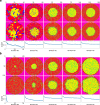A computational model of stem cells' decision-making mechanism to maintain tissue homeostasis and organization in the presence of stochasticity
- PMID: 35654903
- PMCID: PMC9163052
- DOI: 10.1038/s41598-022-12717-0
A computational model of stem cells' decision-making mechanism to maintain tissue homeostasis and organization in the presence of stochasticity
Abstract
The maintenance of multi-cellular developed tissue depends on the proper cell production rate to replace the cells destroyed by the programmed process of cell death. The stem cell is the main source of producing cells in a developed normal tissue. It makes the stem cell the lead role in the scene of a fully formed developed tissue to fulfill its proper functionality. By focusing on the impact of stochasticity, here, we propose a computational model to reveal the internal mechanism of a stem cell, which generates the right proportion of different types of specialized cells, distribute them into their right position, and in the presence of intercellular reactions, maintain the organized structure in a homeostatic state. The result demonstrates that the spatial pattern could be harassed by the population geometries. Besides, it clearly shows that our model with progenitor cells able to recover the stem cell presence could retrieve the initial pattern appropriately in the case of injury. One of the fascinating outcomes of this project is demonstrating the contradictory roles of stochasticity. It breaks the proper boundaries of the initial spatial pattern in the population. While, on the flip side of the coin, it is the exact factor that provides the demanded non-genetic diversity in the tissue. The remarkable characteristic of the introduced model as the stem cells' internal mechanism is that it could control the overall behavior of the population without need for any external factors.
© 2022. The Author(s).
Conflict of interest statement
The authors declare no competing interests.
Figures







References
MeSH terms
LinkOut - more resources
Full Text Sources
Medical

